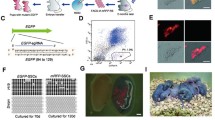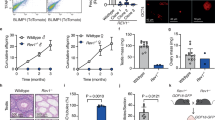Abstract
DNA-mediated transformation of hypoxanthine guanine phosphoribosyl transferase (HPRT)-deficient cells was used to assess the state of the X chromosome Hprt gene in spermatogenic cells. It had been shown previously that DNA from the inactive X chromosome of somatic cells functions poorly or not at all in HPRT transformation, indicating that DNA modification is involved in somatic cell X chromosome inactivation (XCI). In contrast, DNA from mature sperm does function in HPRT transformation suggesting that DNA modification may not be the basis of XCI in mature sperm. In this paper, transformation of HPRT− mouse and hamster cells has been performed to test the nature of XCI during earlier stages of spermatogenesis. DNA from these developing murine germ cells was shown to be capable of HPRT transformation, extending the observation that XCI in sperm does not appear to involve a DNA modification. We also show here that DNA from mature sperm of marsupials functions in HPRT transformation, a result consistent with a role for sperm XCI in the evolution of somatic X inactivation.
Similar content being viewed by others
References
Ashman CR (1978) Mutations in the structural genes of CHO cell histidyl-, valyl-, and leucyl-tRNA synthetases. Somat Cell Genet 4:299–312
Atkins JH, Gartler SM (1968) Development of a nonselective technique for studying 2,6-diaminopurine resistance in an established murine cell line. Genetics 60:781–792
Bellvé AR, Cavicchia JC, Millette CF, O'Brien DA, Bhatnagar YM, Dym M (1977a) Spermatogenic cells of the prepuberal mouse. Isolation and morphological characterization. J Cell Biol 74:68–85
Bellvé AR, Millette CF, Bhatnagar YM, O'Brien DA (1977b) Dissociation of the mouse testis and characterization of isolated spermatogenic cells. J Histochem Cytochem 25:480–494
Blin N, Stafford PW (1976) A general method for isolation of high molecular weight DNA from eukaryotes. Nucleic Acids Res 3:2383–2308
Cattanach BM (1975) Control of chromosome inactivation. Ann Rev Genet 9:1–18
Chapman VM, Kratzer PG, Siracusa LD, Quarantillo BA, Evans R, Liskay RM (1982) Evidence for DNA modification in the maintenance of X chromosome inactivation of adult mouse tissues. Proc Natl Acad Sci USA 79:5357–5361
Charlesworth B (1978) Model for evolution of Y chromosomes and dosage compensation. Proc Natl Acad Sci USA 75:5618–5622
Cooper DW (1971) Directed genetic change model for X chromosome inactivation in eutherian mammals. Nature 230:292–294
Cooper DW, Johnston PG, Sharman GB, VandeBerg JL (1977) The control of gene activity on eutherian and metatherian X chromosomes: a comparison. In: Calaby JH, Tyndale-Biscoe CH (eds) Reproduction and evolution, Australian Academy of Science, Canberra, pp 81–87
Gerton GL, Millette CF (1984) Generation of flagella by cultured mouse spermatids. J Cell Biol 98:619–628
Giles NH, Partridge CWH, Nelson NJ (1957) The genetic control of adenylosuccinase in Neurospora crassa. Proc Natl Acad Sci USA 43:305–317
Harris H, Hopkinson DA (1976) Hypoxanthine phosphoribosyl transferase (HPRT). Handbook of enzyme electrophoresis in human genetics, North Holland Pub Co, Amsterdam pp 2.4.2.8
Johnston PG, Cattanach BM (1981) Controlling elements in the mouse. IV. Evidence of non-random X-inactivation. Genet Res 37:151–160
Joho R, Weissman IL, Early P, Cole J, Hood L (1980) Organization of K light chain genes in germ-line and somatic tissue. Proc Natl Acad Sci USA 77:1106–1110
Kratzer PG, Chapman VM, Lambert H, Evans RE, Liskay RM (1983) Differences in the DNA of the inactive X chromosomes of fetal and extraembryonic tissues of mice. Cell 33:37–42
Lester SC, LeVan SK, Steglich C, DeMars R (1980) Expression of human genes for adenine phosphoribosyl transferase and hypoxanthine guanine phosphoribosyl transferase after genetic transformation of mouse cells with purified human DNA. Somat Cell Genet 6:241–260
Lester SC, Korn NJ, DeMars R (1982) Derepression of genes on the human inactive X chromosome: evidence for differences in locus specific rates of derepression and rates of transfer of active and inactive genes after DNA-mediated transformation. Somat Cell Genet 8:265–284
Lifschytz E, Lindsley DL (1972) The role of X chromosome inactivation during spermatogenesis. Proc Natl Acad Sci USA 69:182–186
Liskay RM, Evans RJ (1980) Inactive X chromosome DNA does not function in DNA-mediated cell transformation for the hypoxanthine phosphoribosyl transferase gene. Proc Natl Acad Sci USA 77:4895–4898
Lyon MF (1974) Evolution of X chromosome inactivation in mammals. Nature 250:651–653
Lyon MF (1977) In: Calaby JH, Tyndale-Biscol CH (eds) Reproduction and evolution, Australian Academy of Science, Canberra, pp 95–98
Lucchesi JC (1978) Gene dosage compensation and the evolution of sex chromosomes. Science 202:711–716
Meistrich ML, Trostle PK, Brock WA (1981) Association of nucleoprotein transitions with chromatin changes during rat spermatogenesis. In: Tagiello G, Vogel HJ (eds) Bioregulators of reproduction. Academic Press, New York pp 151–166
Millette CF, O'Brien DA, Moulding CT (1980) Isolation of plasma membranes from purified mouse spermatogenic cells. J Cell Sci 43:279–299
Monesi V (1971) Chromosome activities during meiosis and spermiogenesis. J Reprod Fertil Suppl 13:1–14
Narayan P, Scott BK, Millette CF, DeWolf WC (1983) Human spermatogenic cell marker proteins detected by two-dimensional electrophoresis. Gamete Res 7:227–239
Rastan S, Cattanach BM (1983) Interaction between the Xce locus and imprinting of the paternal X chromosome in mouse yolk-sac endoderm. Nature 303:635–637
Rastan S, Kaufmann MH, Handyside AH, Lyon MF (1980) X chromosome inactivation in extraembryonic membranes of diploid parthenogenetic mouse embryos demonstrated by differential staining. Nature 288:172–173
Romrell LJ, Bellvé AR, Fawcett DW (1976) Separation of mouse spermatogenic cells by sedimentation velocity. A morphological characterization. Dev Biol 49:119–131
Ropers HH, Wolff G, Hitzeroth HW (1978) Preferential X-inactivation in human placenta membranes: Is the paternal X inactive in early embryonic development of female mammals? Hum Genet 43:265–273
Sharman GB (1971) Late DNA replication in the paternally derived X chromosome of female kangaroos. Nature 230:231–232
Shin S, Meera Khan P, Cook PR (1971) Characterization of hypoxanthine guanine phosphoribosyl transferase in man-mouse somatic cell hybrids by an improved electrophoretic method. Biochem Genet 5:91–99
Siniscalco M, Klinger HP, Eagle H, Koprowski H, Fujimoto WY, Seegmiller JE (1969) Evidence for intergenic complementation in hybrid cells derived from two human diploid strains each carrying an X-linked mutation. Proc Natl Acad Sci USA 62:793–799
Solari AJ (1974) The behavior of the XY pair in mammals. Int Rev Cytol 38:273–317
Steele, MW (1976) On the evolution of X-chromosome inactivation in mammals and the clinical consequences to man — a hypothesis. Medical Hypothesis 2:195–199
Takagi N, Sasaki M (1975) Preferential inactivation of the paternally derived X-chromosome in the extraembryonic membranes of the mouse. Nature 256:640–641
VandeBerg JL, Cooper DW, Sharman GB, Poole WE (1977) Studies on metatherian sex chromosomes. IV. X linkage of PGK-A with paternal X inactivation confirmed in erythrocytes of grey kangaroos by pedigree analysis. Aust J Biol Sci 30:115–125
Venolia L, Gartler SM (1983a) Comparison of transformation efficiency of human active and inactive X chromosomal DNA. Nature 302:82–83
Venolia L, Gartler SM (1983b) Transformation of the Hprt gene with sperm DNA. Somat Cell Genet 9:617–627
Venolia L, Gartler SM, Wassman ER, Yen P, Mohandas T, Shapiro LJ (1982) Transformation with DNA from 5-azacytidine-reactivated X-chromosomes. Proc Natl Acad Sci USA 79:2352–2354
Wake N, Takagi N, Sasaki M (1976) Non-random inactivation of X chromosomes in the rat yolk sac. Nature 262:580–581
Wigler M, Pellicer A, Silverstein S, Axel R (1978) Biochemical transfer of single-copy eucaryotic genes using total cellular DNA as donor. Cell 14:725–731
Author information
Authors and Affiliations
Rights and permissions
About this article
Cite this article
Venolia, L., Cooper, D.W., O'Brien, D.A. et al. Transformation of the Hprt gene with DNA from spermatogenic cells. Chromosoma 90, 185–189 (1984). https://doi.org/10.1007/BF00292395
Received:
Issue Date:
DOI: https://doi.org/10.1007/BF00292395




